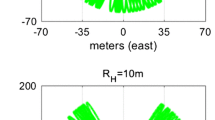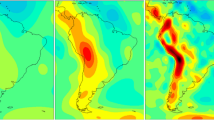We present the results of analyzing the radio-wave refractive characteristics measured on the radio-occultation paths between the GPS navigation satellites and the FORMOSAT-3 research satellites in the central region of the European territory of Russia in 2007–2013. The diurnal, seasonal, and annual variations in the refraction angle at altitudes of 2 to 25 km are discussed. It is shown that the refraction angle can be used as an independent characteristic of the atmospheric state and its long-term variation trends. Diurnal and nocturnal variations in the refraction angle in the winter and summer seasons are analyzed. Trends in the atmospheric refraction variations over seven years are discussed.
Similar content being viewed by others
References
O. I. Yakovlev, Space Radio Science, Taylor and Francis, London (2002).
Special Issue of Terrestrial, Atmospheric and Oceanic Science, 11, No. 1 (2000).
C. Reigber, H. Lühr, and P. Schwintzer, ed., First CHAMP Mission Results for Gravity, Magnetic and Atmospheric Studies, Springer, Berlin (2003).
G. Kirchengast, U. Foelsche, and A. Steiner, ed., Occultations for Probing Atmosphere and Climate, Springer-Verlag, Berlin (2004).
A. Steiner, B. Pirscher, U. Foelsvhe, and G. Kirchengast, ed., New Horizons in Occultation Research. Studies in Atmosphere and Climate, Springer, Heidelberg (2009).
O. I. Yakovlev, A.G. Pavelyev, and S. S. Matyugov, Satellite Monitoring of the Earth. Radio-Occultation Monitoring of the Atmosphere and Ionosphere [in Russian], URSS, Moscow (2010).
S. B. Healy and J.-N. Thépaut, Q. J. R. Meteorol. Soc., 132, No. 615, 605 (2006).
A. S. Gurvich, M. E. Gorbunov, and L. Kornblueh, Atmos. Oceanic Phys., 42, No. 6, 709 (2006).
D. Pindel and A. Rhodin, in: New Horizons in Occultation Research, Springer, Heidelberg (2009), p. 111.
M. A. Ringer and S.B. Healy, Geophys. Res. Lett., 35, No. 5, L05708 (2008).
A.K. Steiner, D. Hunt, S.-P. Ho, et al., Atmos. Chem. Phys., 13, No. 3, 1469 (2013).
A. A. Pavel’ev, S. S. Matyugov, A.G. Pavel’ev, and O. I. Yakovlev, J. Commun. Tech. Electron., 57, No. 8, 755 (2012).
Yu. S. Sedunov, S. I. Avdyushin, et al., The Atmosphere: A Reference Book (Reference Data and Models) [in Russian], Gidrometeoizdat, Leningrad (1991).
Author information
Authors and Affiliations
Corresponding author
Additional information
Translated from Izvestiya Vysshikh Uchebnykh Zavedenii, Radiofizika, Vol. 60, No. 5, pp. 387–395, May 2017.
Rights and permissions
About this article
Cite this article
Matyugov, S.S., Yakovlev, O.I., Pavelyev, A.G. et al. Refraction of Radio Waves on the Radio-Occultation Satellite-to-Satellite Paths as a Characteristic of the Atmospheric State. Radiophys Quantum El 60, 347–354 (2017). https://doi.org/10.1007/s11141-017-9805-z
Received:
Accepted:
Published:
Issue Date:
DOI: https://doi.org/10.1007/s11141-017-9805-z




